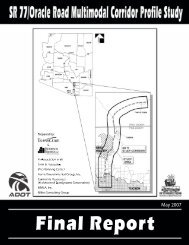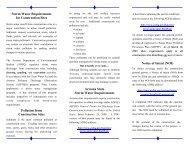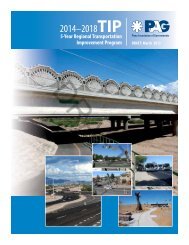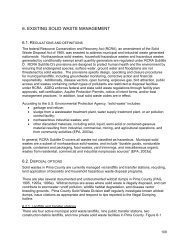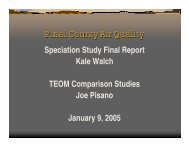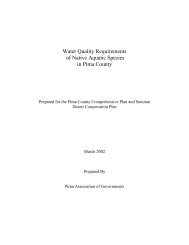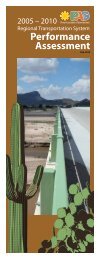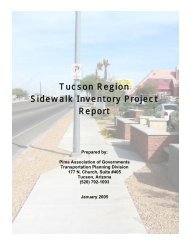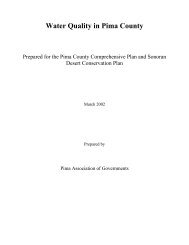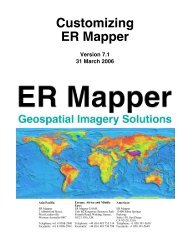Final Report - Pima Association of Governments
Final Report - Pima Association of Governments
Final Report - Pima Association of Governments
You also want an ePaper? Increase the reach of your titles
YUMPU automatically turns print PDFs into web optimized ePapers that Google loves.
High Capacity Transit System Plan - <strong>Final</strong> <strong>Report</strong> June 2009<br />
HCT Implementation Strategy<br />
streetcar service on 6th Avenue to the initial streetcar line may be a challenge because there is<br />
likely to be some overlap in the downtown area.<br />
Existing and Programmed/Planned Transit Service<br />
Fixed‐route bus service is currently provided along 6th Avenue. Route 8, which runs from the<br />
Laos Transit Center along 6th Avenue to the Ronstadt Transit Center and then out Broadway<br />
Boulevard to Wilmot Road, has a weekday ridership <strong>of</strong> over 10,000 passengers. Route 8 service<br />
during both weekdays and weekends was recently extended. Existing express bus service for the<br />
Northwest/Aero Park Express (202X) and the Oro Valley/Aero Park Express (203X) both stop at<br />
the Laos Transit Center and then continue on Nogales Highway to the Raytheon plant. Each <strong>of</strong><br />
these routes runs three buses during the morning and evening commute periods. An additional<br />
express route will be added, which will travel on 6th Avenue from the Laos Transit Center to<br />
downtown Tucson, stopping at the Ronstadt Transit Center.<br />
HCT Implementation Constraints<br />
For the portion <strong>of</strong> the corridor operating along 6th Avenue/Nogales Highway, forecasted level <strong>of</strong><br />
service is good enough that HCT (BRT or streetcar) should be able to operate in mixed traffic with<br />
minimal adverse impact on general‐purpose traffic and with minimal delay due to general<br />
purpose traffic. General‐purpose lane conversion is not feasible along this route. TSP can be<br />
implemented and would benefit BRT and streetcar operation along this corridor. Implementation<br />
<strong>of</strong> HCT stations, particularly on the 6th Avenue segment could be difficult considering the lack <strong>of</strong><br />
right‐<strong>of</strong>‐way and potential resistance <strong>of</strong> neighborhoods to adding HCT along this route.<br />
The primarily constraint for streetcar on 6th Avenue/Nogales Highway is that it does not appear<br />
to be an ideal extension <strong>of</strong> the initial downtown route <strong>of</strong> the modern streetcar. A mid‐route<br />
overlap <strong>of</strong> the two streetcar lines will limit the amount <strong>of</strong> service that can be provided on both<br />
lines.<br />
A mobility‐focused BRT service can be implemented in this corridor relatively quickly if it<br />
commences with mixed‐traffic operation. Stations should be designed to allow for future streetcar<br />
service or a future rubber‐tired circulator service.<br />
Implementation Plan<br />
BRT Service<br />
The estimated capital cost <strong>of</strong> $17.5 million for BRT service in the 6th Avenue/Nogales Highway<br />
corridor indicates that the project is eligible to qualify for Very Small Starts funding. As such, it is<br />
recommended that the implementation plan follow the Project Development process associated<br />
with Very Small Starts. The specifics <strong>of</strong> the implementation are, accordingly, analogous to the<br />
plan described above for Broadway Boulevard BRT, but the 6th Avenue/Nogales Highway BRT<br />
implementation plan differs from the Broadway Boulevard BRT implementation plan in one key<br />
respect: The alternatives are streetcar, BRT operating in mixed traffic, BRT operating in a<br />
dedicated lane, and the baseline alternative.<br />
170



